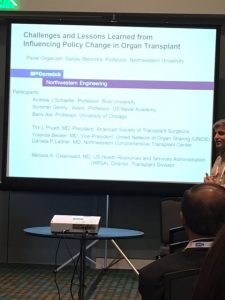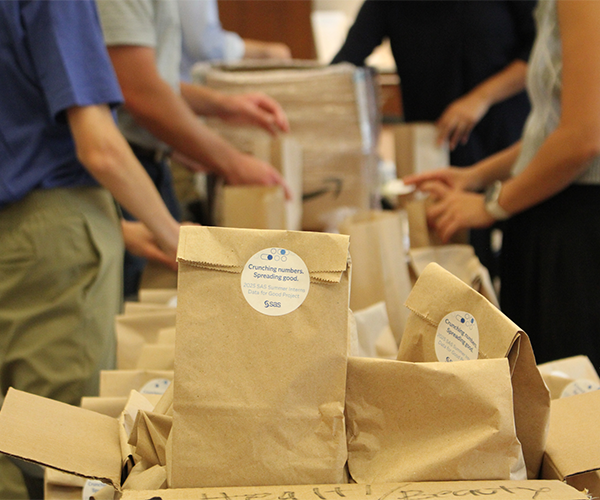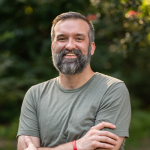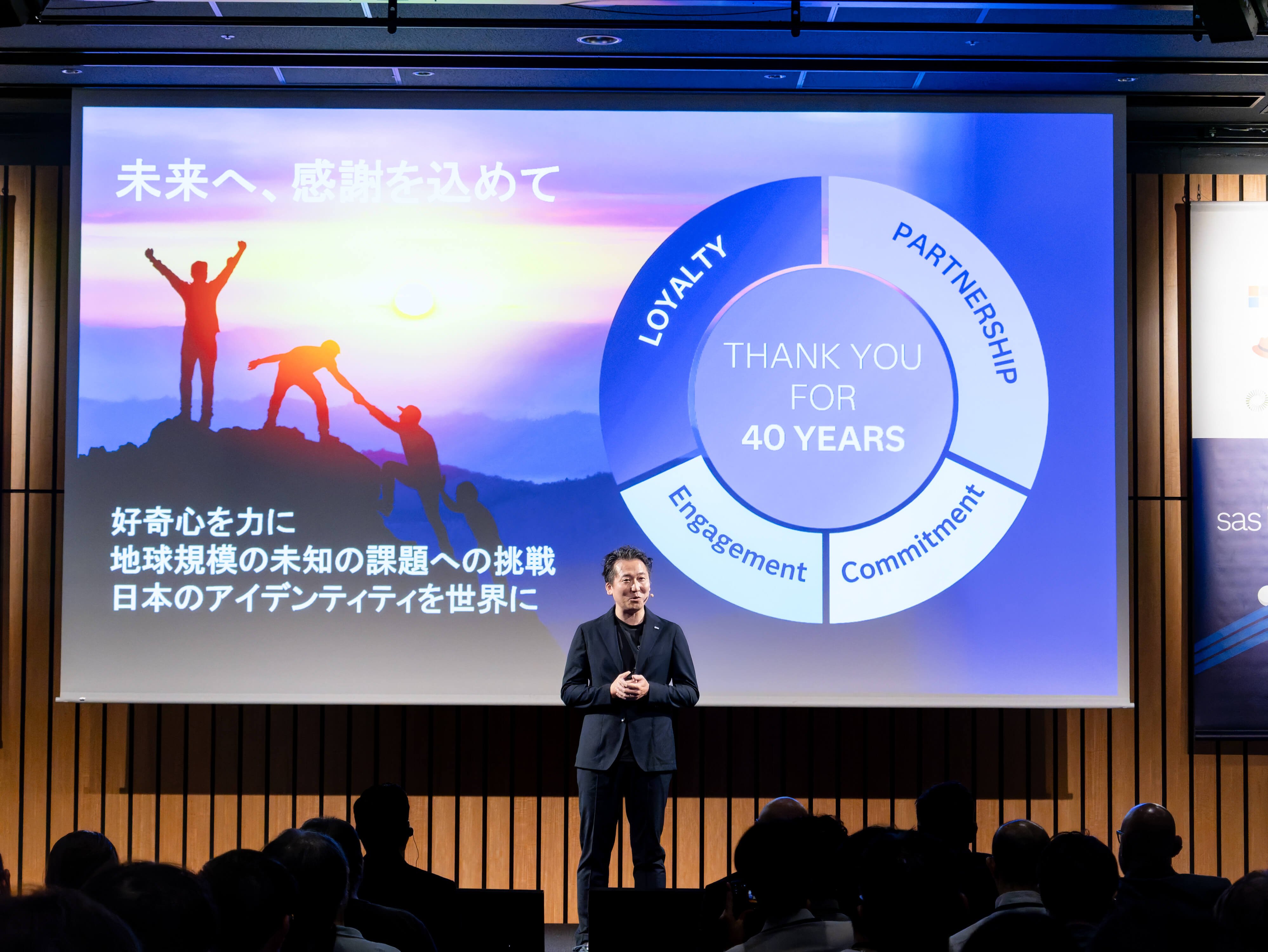In honor of today’s #GivingTuesday, which "harnesses the potential of social media and the generosity of people around the world to bring about real change in their communities,” I’ve been thinking about what constitutes “real change” and the role analytics can play on the many social issues our planet faces. The beauty of #GivingTuesday is that “it provides a platform….to encourage the donation of time, resources and talents to address local challenges." As more and more data scientists want to use their talents in the data4good movement, what does it take for analytics to make a serious impact?
 Two weeks ago I heard two very interesting talks on data4good at the INFORMS Annual Meeting, where 5,000+ people focused on operations research gathered together. The first was on “Challenges and Lessons Learned from Influencing Policy Change in Organ Transplantation.” As you can see from the photo I took, this session combined quite a distinguished group of operations research (OR) academics and transplant surgeons who both want to make an impact. For many reasons, a pure market-based approach is not the best way to allocate organs for transplant, so the process is governed by policy makers, who have divided the country into regions. All parties agree that the current regional system results in disparities in access and is broken, but policy makers have been unable to settle on a solution.
Two weeks ago I heard two very interesting talks on data4good at the INFORMS Annual Meeting, where 5,000+ people focused on operations research gathered together. The first was on “Challenges and Lessons Learned from Influencing Policy Change in Organ Transplantation.” As you can see from the photo I took, this session combined quite a distinguished group of operations research (OR) academics and transplant surgeons who both want to make an impact. For many reasons, a pure market-based approach is not the best way to allocate organs for transplant, so the process is governed by policy makers, who have divided the country into regions. All parties agree that the current regional system results in disparities in access and is broken, but policy makers have been unable to settle on a solution.
Because this situation is a classic market-matching problem it has drawn the attention of the operations research field.* Over the years the academics on the panel had proposed a variety of mathematical solutions. But the most elegant mathematical model for a real world problem adds little value if it is not implemented. So why haven’t they solved the problem? Part of it is as simple and frustrating as problem definition. Are they trying to help those who are the sickest or those most likely to succeed with a transplant? Is it fair that some regions have shorter waiting lists because more organs are available due to increased deaths? Agreeing on the problem definition is tough, and as the clinicians explained, they “argue a lot, because life matters.”
The other session that triggered my thinking was a tutorial on healthcare analytics by Joris van de Klundert of the Erasmus University Institute of Health Policy and Management, who gave a challenge to the OR professionals in attendance. Healthcare analytics is a critical area for the world’s population but one where his fellow researchers in OR are making only a modest contribution. A big part of the problem is too much emphasis on research and too little on results that actually improve healthcare. His literature review of articles on healthcare analytics at various stages of the analytical life cycle highlighted this fact. The vast majority of research is in model building, with fewer and fewer articles published as you move along the cycle to solution development, then model implementation, and finally evaluation and monitoring. There was a lively discussion among the audience of the challenges, which include difficulty as academics getting involved in practice, the conflict between the simple models most often needed and those that will result in publication, and the risk tenure-track faculty face doing work that may not result in the right kind of publications.
After listening to these data4good talks I propose these tips to ensure your application of analytics have a real impact:
- Take time to listen to your “customer.” Even in the social sector realm, you still have “customers,” who are the people or groups for whom you are trying to solve the problem. The transplant surgeons emphasized that it takes a lot of time to build relationships between clinicians and what they called “engineers,” in part because of the big gap that can exist between what these two groups value. Be sure to explain your results, to increase the credibility of your model. As the San Bernadino County Department of Behavioral Health found, discussing their analysis with many of their partners in care helped them align on the goals they shared.
- Build models that match the problem as well as the solution. This means ensuring that you have defined the problem correctly, which as I indicated with the thorny organ transplant discussion maybe far more than half the battle. This also relates back to listening to your “customer.” SAS is working with DataKind and the Boston Public Schools to optimize their bus routes, and as we do so we have to periodically check in to see if the initial models we propose would make sense in practice. People who know math must talk to people who know buses to know if the model will work.
- Focus on putting models into practice. Modeling the problem is important, but as van de Klundert’s literature review shows, the OR community has plenty of success in this area. The challenge is working closely enough (see items 1 and 2 above) with your “customer” to find a path to implementation. After all, as one of the academics said “our endless models don’t necessarily provide the details practitioners want.” So find the details they do want, put them into your model, and work with them to put that model into practice. As Jake Porway, founder of DataKind, blogged: “we cannot make change with technology or data alone.”
- Remember Occam’s razor, or the simplest solution is often the best. For all your interest in trying out the latest non-negative matrix factorization model, a simple logistic regression is often hard to beat. And it will be far more interpretable to most non-analytics professionals.
Today’s #GivingTuesday celebrates giving of all forms, and the social sector could benefit so much from the talent of data scientists (in fact, what sector wouldn’t benefit?). But as Jake Porway likes to say, “you can’t just hack your way to social change.” You must consider impact from the start for your data4good efforts to succeed. After all, who wants to give their time and talent without it making a difference?
* Alvin Roth shared the Nobel Prize for his work in this area, "for the theory of stable allocations and the practice of market design," and while he is a professor of economics at Stanford his PhD is in operations research.





